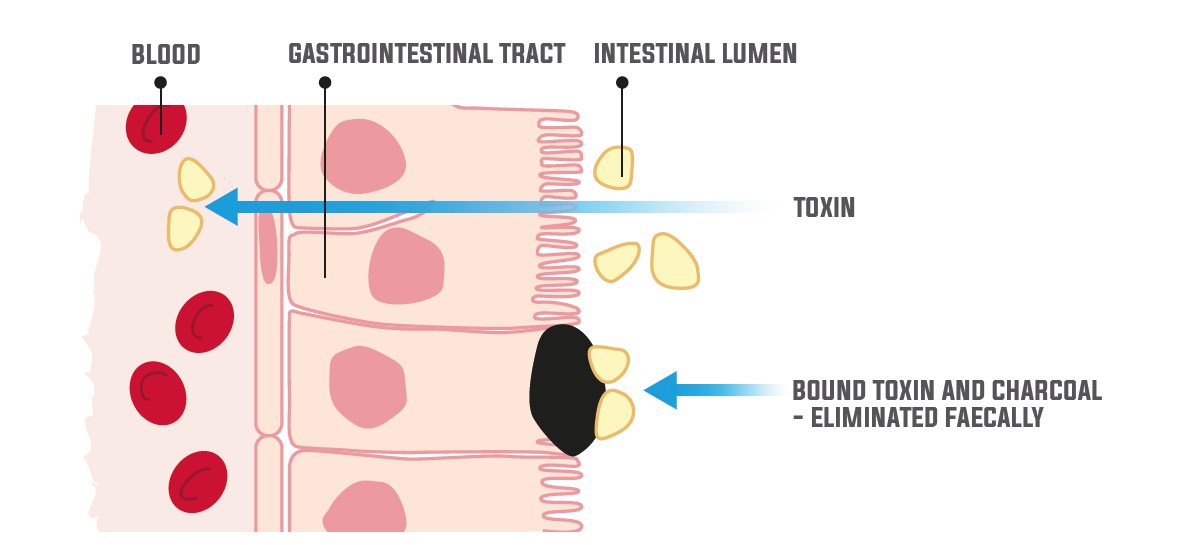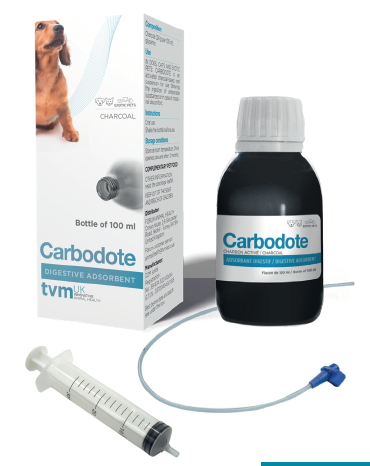Blog - What is activated charcoal and when should I be using it?
Long before it was fashionable enough to be found in trendy drinks, cosmetics and smoothies, Activated Charcoal (or AC) has been widely used as a method of gastrointestinal decontamination for both humans and animals. But what is it, and when should you be using it (and when not)?
*This blog is for veterinary professionals only. If you are a pet owner, please visit our owner resources section.*
What is activated charcoal?
Whilst ordinary charcoal is produced by pyrolysis (heating to extreme temperatures in the absence of oxygen), Activated Charcoal is additionally heated with steam or hot air in order to affect the internal structure of the carbon. This ‘activation’ process creates an irregular lattice structure and also forms a multitude of additional microscopic alveoli or pores – with both factors increasing the surface area to make it extremely adsorptive. This surface area is so large in relation to the volume of AC, it means that a 20g bottle of Carbodote (TVM’s own AC) would have approximately the same surface area as seven football pitches!
This microporosity makes it ideal for adsorbing organic compounds such as drugs and toxins that may have been ingested (whether they be dissolved solid, liquid or gaseous). One thing to always bear in mind is that AC adsorbs elements non-specifically – so it could also adsorb any food or medications which are also in the gastrointestinal tract.
When should I be using it?
AC is often administered after an emetic. While the emetic will generally remove up to 60% of the ingested toxin from the gastrointestinal tract (depending very much on the toxin and the timeframe since ingestion), the activated charcoal coats the gut wall to limit further absorbtion of the unwanted molecules by bonding to them – before being eliminated from the body faecally.
As you will already know from our wide range of guidelines there are many foods and substance that are toxic to pets, but Activated Charcoal is only effective in certain cases. Some poisons or drugs will not be readily adsorbed by AC, and for those that are some may need more than one administration of AC depending on how the liver processes them (depending on whether or not the substance will be entero-hepatically recycled).
This all seems very complicated – especially in poisoning cases when time is very much of the essence.
That is why we have produced a guide on when to use our Activated Charcoal (and when not to). It lists the toxins and drugs on which AC will have a minimal or no effect, so that you don’t waste time in critical poisoning scenarios. It also gives guidance on which cathartics to use and how much. We have even added an * next to all of the toxins on our list which are entero-hepatically recycled – so that you know at a glance whether a single or repeated administration will be required.
Traditional AC was time-consuming and messy to prepare. The fact it had to be made from a powder or presented in large bottles meant for large animal use meant that it was prone to sedimentation or clogging syringes or feeding tubes, which made it difficult to administer and even harder to administer.
TVM’s Carbodote is a ready to use formulation which is designed as a ‘grab and go’ solution. Unlike the larger bottles of ‘sludge’ on the market, the size of the bottle and its formulation ensure that it remains a stable homogeneous solution which can easily be drawn into (and administered from) a syringe. You can also administer through a naso-gastric tube.
Administration is easier too, at 5ml per kg (or 1 bottle per 20kg). Unless the product is entero-hepatically recycled (passed back to the gut again from the liver), a single administration should suffice. Specialists advise that the first administration of AC should preferably be given with a cathartic (a cathartic will decrease gut transit time, allowing the bound poison to pass out the back end quickly).
If the product is entero-hepatically recycled then AC should be repeated every 4-6 hours for at least 24 hours (only giving a cathartic with the initial administration of activated charcoal).
It is suitable for dogs, cats and exotic pets.
*Study C14-2017/DPh
What is osteoarthritis? Osteoarthritis is one of the most common diseases in dogs. It’s estimated around 20–40% of dogs are affected1,2 – or almost 80% in older dogs.2 Osteoarthritis is a degenerative inflammatory disease, involving progressive deterioration of healthy joints. This often leads to joint instability, weakness and pain. Right now, osteoarthritis remains incurable and
Epilepsy management – which medications should I use first?
Liquid, gel, powder or tablets? What type of activated charcoal product is best for my poisoned patient?!
‘Vaping’ is increasingly popular, but is the use of e-cigarettes or ENDS (electronic nicotine delivery systems) harmful to our pets? e-cigarettes contain nicotine, which is toxic to pets and may result in the following symptoms; salivation, vomiting, diarrhoea, agitation, panting, tachycardia (fast heart rate), dilated pupils, high blood pressure, tremors, seizures and in very severe
No Description

